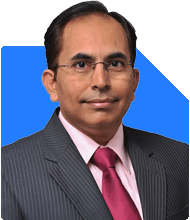Ramalingam Kalirajan |10241 Answers |Ask -Follow
Mutual Funds, Financial Planning Expert - Answered on Jun 20, 2025
He has an MBA in finance from the University of Madras and is a certified financial planner.
He is the director and chief financial planner at Holistic Investment, a Chennai-based firm that offers financial planning and wealth management advice.... more

Hello Sir, I am a retired 60 yr old man. My current corpus is as follows MF - Rs 1.30 Cr FD - Rs 20 Lacs Stocks - Rs 10 Lacs SCSS- Rs 15 Lacs My requirement is Rs 1 Lac a month for my living. Can my corpus sustain for 25 yrs based on my monthly requirement Kindly let me know what i need to do Regards
You have a good corpus and clear monthly requirement.
Let us create a strategy to make it last for 25 years.
1. Current Corpus Overview
Mutual Funds (equity/hybrid): Rs.?1.30 crore
Fixed Deposits: Rs.?20 lakh
Stocks: Rs.?10 lakh
SCSS (Senior Citizen Saving Scheme): Rs.?15 lakh
Total: Rs.?1.75 crore
You need Rs.?1 lakh per month for living.
Annual requirement: Rs.?12 lakh per year.
2. Assess Sustainability Of Corpus
To withdraw Rs.?12 lakh annually from Rs.?1.75 crore means ~6.9% withdrawal rate.
This is broadly sustainable if net returns can match this after tax and inflation.
Returns scenario:
Debt/hybrid returns ~6–8%
Equity returns ~8–10%
SCSS offers ~8% tax-free
FD yields ~6–7% taxable
A blended withdrawal of ~7% annually may be viable for 25 years, if returns hold up.
3. Restructure Asset Allocation
You should rebalance to de-risk and build income sustainability:
Suggested Allocation
Hybrid Balanced Funds: 40% (Rs.?70 lakh)
Provides equity exposure and stable income
Debt Funds / Liquid Funds: 20% (Rs.?35 lakh)
For emergency cushion and short-term needs
Equity Mutual Funds: 20% (Rs.?35 lakh)
For long-term growth and inflation hedge
SCSS: 15% (Rs.?15 lakh)
Already tax-free yield; good for income stability
Fixed Deposits: 5% (Rs.?10 lakh)
Use for immediate liquidity; ladder for short-term needs
Stocks: Can shift Rs.?10 lakh to hybrid or equity to match this allocation.
4. Weekly & Monthly Income via SWP
Systematic Withdrawal Plans (SWPs) can generate monthly income:
Use hybrid balanced fund SWP of Rs.?50,000/month
Use equity mutual fund SWP of Rs.?25,000/month
Use SCSS payout (quarterly or monthly) ~Rs. 10,000
Use FD interest monthly via laddered withdrawal ~Rs.?3,000
Adjust to reach Rs.?1 lakh total
This provides regular income with tax efficiency.
5. Emergency & Buffer Planning
Keep at least 6 months expenses (Rs.?6 lakh) in liquid/debt funds.
This ensures no equity selling during downturn.
Use remaining debt funds for short-term buffer.
6. Tax Considerations on Withdrawals
Equity fund LTCG beyond Rs.?1.25 lakh taxed at 12.5%
Debt/hybrid gains taxed as per slab
SCSS interest is taxable unless kept under tax-saving deposit
Use SWP to smooth income and manage tax liability year-round
7. Health Cover & Longevity Safety Net
At age 60, medical expenses likely rise significantly
Carry a health policy of at least Rs.?10–15 lakh renewal coverage
Add senior citizen riders if possible
Consider top-ups after 65
This protects corpus from medical shocks
8. Minimising Investment Charges and Risks
Use actively managed hybrid and equity funds; avoid index funds
Actively managed funds handle market fluctuations
They offer downside protection during volatility
Avoid direct plans; as post-retirement, you need ongoing financial advice
Avoid ULIPs, annuities, and speculative products
9. Withdrawal Strategy Review and Adjustments
Review withdrawals semi-annually
Adjust SWP rates if expenditure changes or markets fluctuate
Rebalance allocation as hybrid or equity grows or shrinks
Maintain shaped glide path to defensiveness over time
10. Estate Planning and Nominations
Ensure all investment accounts have current nominations
Create a simple will covering assets and bank accounts
Arrange power of attorney if needed
This helps family in managing affairs smoothly
11. Risk of Longevity and Inflation
You may need income beyond standard life expectancy
Ensure equity portion sustains corpus over time
Reevaluate strategy every 3–5 years to reflect inflation, healthcare, etc.
12. Summary Roadmap
Immediate: Rebalance portfolio; set SWP to generate income; buy health cover
Within 6 months: Build debt/liquid buffer; update nominations and will
Ongoing: Monitor withdrawals, rebalance annually, adjust SWP based on expenditures
Long-Term: Post 85 years, reduce equity gradually and rely more on debt/SCSS/FD income
Final Insights
Your corpus of Rs.?1.75 crore can support Rs.?1 lakh/month for 25 years.
A structured SWP strategy across hybrid, equity, SCSS, and FD is key.
Health insurance and buffer protection are essential.
Actively managed funds via regularly advised plans are preferable.
Review and rebalance periodically for sustainable growth and comfort.
You are well placed to live independently and securely with this plan.
Best Regards,
K. Ramalingam, MBA, CFP,
Chief Financial Planner,
www.holisticinvestment.in
https://www.youtube.com/@HolisticInvestment
Let's embark on this financial journey together.
You can reach me through my website mentioned below.
This platform has restrictions on sharing personal contact. Hope you understand.
Best Regards,
K. Ramalingam, MBA, CFP,
Chief Financial Planner,
www.holisticinvestment.in
Insagram: https://www.instagram.com/holistic_investment_planners/
You may like to see similar questions and answers below
Ramalingam Kalirajan |10241 Answers |Ask -Follow
Mutual Funds, Financial Planning Expert - Answered on Apr 30, 2024
Ramalingam Kalirajan |10241 Answers |Ask -Follow
Mutual Funds, Financial Planning Expert - Answered on Jun 06, 2024
Ramalingam Kalirajan |10241 Answers |Ask -Follow
Mutual Funds, Financial Planning Expert - Answered on Dec 13, 2024
Janak Patel |65 Answers |Ask -Follow
MF, PF Expert - Answered on Jun 05, 2025
Nayagam P P |10303 Answers |Ask -Follow
Career Counsellor - Answered on Aug 15, 2025
Nayagam P P |10303 Answers |Ask -Follow
Career Counsellor - Answered on Aug 15, 2025
Nayagam P P |10303 Answers |Ask -Follow
Career Counsellor - Answered on Aug 15, 2025
Nayagam P P |10303 Answers |Ask -Follow
Career Counsellor - Answered on Aug 15, 2025
Nayagam P P |10303 Answers |Ask -Follow
Career Counsellor - Answered on Aug 15, 2025
Nayagam P P |10303 Answers |Ask -Follow
Career Counsellor - Answered on Aug 15, 2025
Nayagam P P |10303 Answers |Ask -Follow
Career Counsellor - Answered on Aug 15, 2025
Nayagam P P |10303 Answers |Ask -Follow
Career Counsellor - Answered on Aug 15, 2025
Nayagam P P |10303 Answers |Ask -Follow
Career Counsellor - Answered on Aug 15, 2025
Nayagam P P |10303 Answers |Ask -Follow
Career Counsellor - Answered on Aug 15, 2025















